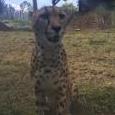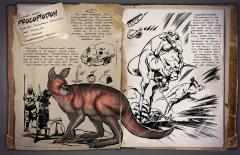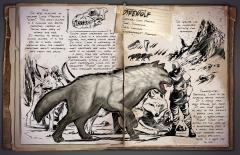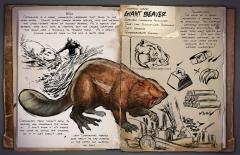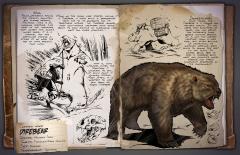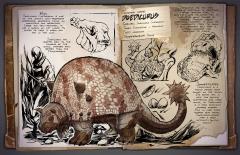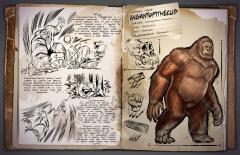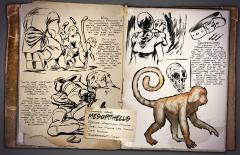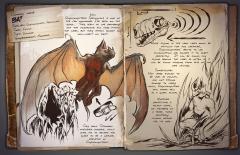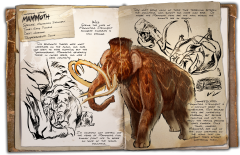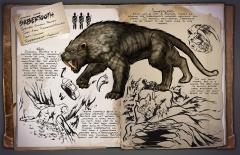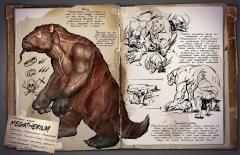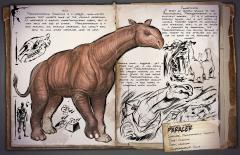Search the Community
Showing results for tags 'mammal'.
-
Could lift up trees and could use it trunk to pick up objects, he could have a platform saddle and be found in desert and arid savanna and would beat the mammoth cause of the functional trunk
-
🦁Feral Sovereign: Presenting the Panthera Spelaea🦁 ⛰️The Panthera Spelaea is an extinct species of carnivorous mammal belonging to the family Felidae, which lived in what is now Spain and the British Isles in the west up to Alaska⛰️ 🤖 🙀."Witness the Feral Sovereign, the Panthera Spelaea. With its Roar of Dominion, it commands the battlefield, weakening foes' resolve. The Bite of Energy Drain saps their vitality, a true conqueror's strike. As the Cave Shadow, it prowls the depths with unmatched prowess. Clad in its Guardian Pelt, it defies the elements, a protector in every sense. A true Hunter of Horizons, its vision spans day and night, tracking all with precision. Bow before the Feral Sovereign, the embodiment of primal supremacy."🙀 👉READ THIS BEFORE YOU START👈 It gives us a lot to present this project in which we have been working to try to give the best proposal. First of all, I would like to clarify that the reason why we chose a big cat is because we see that Ark only exists today, the saber-toothed cat, the Shadowmane is a fictional animal, and the Thylacoleo is a marsupial, so we treat to obtain the best attributes of the Panthera Spelaea to have a strong suggestion and a chance to expand the niche it would work in. Being more a type of predator that can attack its prey in a fast and forceful way, rather than opting for a long and repetitive fight in the aspect that it is not a battle for "mashing the buttons" 👾First mammal with Tek Mount👾 🤖Considering that this big cat is a killing machine, we assume that after the ascension you will be able to equip it with a tek mount. This mount is capable of deploying small drones that will project a holographic shield that will protect you from the front. It has a series of propellers that will help you make longer jumps and be able to run through the water, even for short distances, they will be enough to reach a destination point.🤖 👀Size👀 Respecting the large size it had in ancient times, we take into account that Panthera Spelaea is larger than a thylacoleo but smaller than a shadowmane, being a midpoint 💥Wild💥 Panthera Spelaea is a ferocious animal found in the northern part of the icy mountains, being more specific in the rocky areas where their dens are located where they rest. For the most part, being in herds made up of females and males, due to their thick fur, they are able to withstand the low temperatures that few are willing to endure. It is possible to see that the temperament of the Panthera Spelaea changes depending on the gender it has, with the females being the most aggressive, hunting small creatures in groups and the males having a temperamental attitude, being close to their den tending the young of the herd. During the night is when the Panthera Spelaea becomes more dangerous since in this case the whole herd together with the alpha male hunting large prey due to the leadership of the Alpha which seems to make the females more lethal than during the day. 💥Domesticated💥 The survivors of the ark have realized that it is impossible to subdue an adult Panthera Spelaea and teach it commands, it simply ignores anyone other than its alpha male and when the alpha is captured they go into a state of crisis and disperse. separating the herd and killing their young by starvation. Seeing that the only viable way to try to have this mount is to wait until nightfall so that the herd leaves its lair and thus can take its young. Panthera Spelaea young, due to their young age, it is easier to teach them correct training until they reach adulthood, resulting in a powerful, strong, agile and fast hunting animal that by itself shines a lot but when in a pack it becomes becomes one of the deadliest animals in these lands. 💪SKILLS💪 1. Mighty Roar: 🙀it is a powerful roar that allows him to remove the states in which he can be found by his enemies (poison, bleed, stun, etc). This ability must be used carefully as it takes a long time to activate again.🙀 2. POWERFUL CLAWS: ☠️His claws, even if you don't do much damage, can make several fast attacks, working as his most used and versatile attack.☠️ 3. Cave Predator: ⛰️The Panthera spelaca has developed exceptional agility and strength in confined spaces, such as the caves on the map. She can move easily and quickly in tight terrain, making her a formidable threat in those environments.⛰️ ⛰️In addition, his visual acuity allows him to track prey and enemies in environments underground, following clues and tracks to locate their prey with ease.⛰️ 4. Lethal Dart: 💥The Panthera spelaea attacks with a quick and precise movement, dealing lethal damage. Activate tactical retreat to escape before enemies can counterattack, leaving only a fleeting flash💥 5. Nocturnal Guardian Fur: 🥶 Its fur is thick and with color variations. Making it harder to spot at night, while providing warmth for your rider and nearby companions..🥶 6. A good companion: 🦴 Keep your Panthera happy with food and petting, and it will purr, giving you and nearby animals a small experience buff.🦴 🦴It would work almost the same as that of the lystrosaurus🦴. 7. Improved vision: 👀Its excellent vision allows it to easily identify other predators compared to the human eye, during the day being able to detect carnivorous animals and improving its vision considerably during the night detecting both carnivores and herbivores, having a very broad perception of the animals around it.👀 Taming 🐈⬛To have a Panthera at your disposal without being attacked you have to look for a herd made up of males and females: the male specimens will be closer to the cubs taking care of them and having a temperamental attitude while the females will be around them being aggressive. You must be skillful enough to capture one of the cubs from the pack in your arms and escape from the parents as quickly as possible before they realize your presence, if they do so the cub may get scared and lose taming efficiency once in your hands raise it and bond by teaching it to hunt, keeping it clean, healthy and well fed, keep a close eye on them, they are known for short attention spans and arrogance..🐈⬛ 👉Basic statistics👈 Health: 850 Stamina: 450 Oxygen: 250 Food: 1750 Weight: 500 Melee damage: 100% Movement speed: 100% Torpor: 850 🦁Sexual dimorphism🦁 Pantheras spelaea can be identified between males and females since the males are equipped with a small melanna that surrounds their necks while the females lack it, this causes the machops specimens to have a bonus of 5% of resistance while females have 5% more melee damage 🟣Variants by zones🟣 Specifically in the underground areas, the snow and the area affected by the corruption we can find these three variants of colors and patterns Specifically in the underground areas, the snow and the area affected by the corruption we can find these three variants of colors and patterns. 1.Snow area: they are characterized by having smooth hair without any type of spots and with very pronounced eye marks that help them see through the snow 2. Corrupt area: This PANTHERA has been affected by the element, developing the typical markings of animals in the area. 3.Underground Zone: It has darker colors in addition to some speckled spots and dark legs that allow it to be more slippery in its environment. (¡¡THESE VARIANTS ARE ONLY AESTHETIC!!) Agradecimientos a AngelGamez,Angel Strange,Neto,DaiRei,Boryini y Cetcat por ayudarme con las imagenes y habilidades 😃
-

combat wombat Diprotodon terraforma!!! The Earthbending Wombat!!!
RaephClark posted a suggestion in Creature submission archive
No way! That wombat is earthbending! Well… not quite, but it seems that the influence of element on Extinction have caused this Diprotodon to be able to move the earth just like your favourite Badgermoles from ATLA! Diprotodon would be the ultimate battlefield tactician and the perfect mount for dealing with an OSD! When I say earthbending wombat, I mean it! Diprotodon has the unique ability to throw up temporary walls, trap creatures and create protective suits of armour for its allies, all with the power of dirt! This would be invaluable in helping you keep the hordes of corrupted at bay, and keep your allies nice and healthy. Let’s dig into the concept! Table of Contents 1. Artwork 2. Dossier Text 3. Potential Base Stats and Spawning 4. Taming 5. Abilities and Controls - An Earthbending Wombat? - Controls - Saddle 6. Supplementary Links Dossier Text Common Name : Diprotodon Species : Diprotodon terraforma Time : Pleistocene Diet : Herbivore Temperament : Territorial Wild A giant relative of the wombat was too darn stubborn to keel over for the apocalypse? Yeah, that checks out. Diprotodon terraforma is a hulking marsupial that is commonly found in small herds, travelling across the wastelands to find enough plant matter to sustain their bulk. For most animals, the hordes of corrupted would make that kind of lifestyle impossible, but this behemoth quite literally fights dirty. Powerful forearms allow it to move enormous loads of soil with ease, and while this is impressive, it’d be a mere annoyance for the more dangerous members of the hivemind. Diprotodon isn’t just throwing sand though, its unique snot is what gives it the upper paw! Sounds disgusting, but its mucus is able to harden loose dirt into a form of organic concrete. With surprising finesse for its size, it shapes the earth into defensive walls, temporary suits of armour or even uses it as a way to entrap enemies! It’s amazing how life has adapted even in this desolate environment! Domesticated A small herd of these marsupials have proved highly effective in defending those orbital supply drops. Their natural defences against corrupted are invaluable in controlling crowds and ensuring their allies are well protected. We’ve found that fitting their saddles with shade cloths helps keep the foul weather of the wastelands at bay too! Potential Base Stats and Spawning Health: 900 Stamina: 300 Oxygen: 150 Food: 3000 Weight: 400 Melee Damage: See "Abilities and Controls" section for base damage values Torpidity: 650 Diprotodon would be found in small herds of around 5 members out in the wastelands, migrating to the Sanctuary and the desert dome to feed. Within these herds, there would be a mix of adult and young individuals, with young kept in the center to protect them from the dangers of a post-apocalyptic Earth. Hopefully the improved AI of ASA could make this herd dynamic possible! Taming With their very stubborn dispositions, it’s near impossible to tame an adult Diprotodon.Being hardened by endless hordes of corrupted, they treat anything foreign as a danger! However, in their tight knit herds, the babies tend to be much more friendly and inquisitive. It’ll be difficult to get past the wall that is their angry parents and relatives though… If you’re brave or foolish enough to sneak into the inner folds of the herd, simply passively feeding the babies Sweet Vegetable Cakes will cause them to follow you, and from there you can lead them away with even more sweet treats to have them join your tribe.Once you’ve raised up the giant pup you’ll have yourself a powerful war steed! Tamed Diprotodon eat berries like any other herbivore. No need to worry about a lavish and expensive diet! Abilities and Controls An Earthbending Wombat? So how exactly does this wombat earthbend?As mentioned in the dossier, it has to do with its snot! Element’s influence on its evolution means that its snot can harden dirt into a concrete-like material. But that’s just the flavour text, how does it work in game? Diprotodon has a dirt meter that is linked to its weight stat. Holding right click fills up this meter and pressing R cycles through three distinct abilities: Dirt Wall: Uses dirt to place temporary walls of dirt. Perfect for blocking off hordes of corrupted and drawing them into choke points. These walls can be destroyed by taking enough damage, or will disappear after a certain amount of time. Dirt Snare: Uses dirt to trap enemies in place, functioning much like how a netgun would Dirt Armour: Uses dirt to create temporary armour on allied tames that increases their damage reduction, but lowers speed significantly on targets smaller than the Diprotodon. Larger targets require more dirt to fully armour. A unique ability of the armour is that itreduces the effects of harmful elemental attacks (like fire damage and poison breath) by half! In terms of controls: Left Click: Bite. 40 Base Damage. Hits at a decent speed and harvests wood Right Click: Ground Slam. 55 base damage, good AOE, but slow Right Click (Hold): Refill dirt 😄 Use dirt ability. Different abilities have different dirt costs R: Cycle dirt ability In terms of saddle: Diprotodon’s saddle is fitted with a simple shade cloth/tent that prevents the player from suffering from the “Harsh Conditions” debuff. Mainly a way to not have to deal with annoying debuffs while fighting those hordes, but would also make Diprotodon a viable ground mount for those that like to stay in on the action. In addition, the saddle could function as a mobile feeding trough. Being almost like a mobile command tent and infirmary, keep your tames fed at range all from the comfort of your giant marsupial. Stock up the beast with veggie cakes to keep your herbivores fighting for longer! Supplementary Links Real World Diprotodon: https://en.wikipedia.org/wiki/Diprotodon The Badgermole Reference material: https://avatar.fandom.com/wiki/Badgermole- 2 replies
-
- brawler/tactician
- mid-late game
-
(and 4 more)
Tagged with:
-
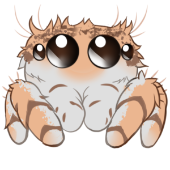
Megalictis : Mutant dire wolverine with a titans temper!
Sovira posted a suggestion in Creature submission archive
I'm Sovira and I'm posting on behalf of Fico who could not make it in time! I did not want to leave him without a chance ❤️ Common Name: Megalictis Species: Megalictis Dirus Time: Miocene Diet: Carnivore Temperament: Aggressive Wild It’s the best there is at what it does and what it does isn’t very nice. If there is one creature that you should not mess with, it is Megalictis ferox. Like their modern relatives the wolverines, these tenacious creatures can come face to face with multiple opponents at once and still come out on top. Fear tactics have no effect on them, and their thick hide shields them from the most brutal of attacks. I’ve rarely seen Megalictis run from a fight, but if they are weakened enough, they tend to discharge a foul-smelling musk that deters enemies while they make their escape. Domesticated Megalictis are quite difficult to tame, as tranquilizers cannot pierce their thick skin and they are impossible to approach. Drugging corpses with Narcotic seems to do the trick with knocking them out, however. The thick fur of Megalictis provides ample insulation to anyone traversing the extreme freezing climates. They are also expert trackers, allowing them to locate their prey after taking a single bite out of them. In battle is where they shine the brightest, as they can latch onto much larger targets with ease, inflicting wounds with their powerful jaws and sharp claws. And they can heal quickly thanks to the exposure to the Element in their environment. Be wary as they take damage, however, as they will go into a berserker rage attacking all enemies in sight with an animalistic fury that rivals even giga’s Abilities •Megalictis's stocky yet fuzzy build allows it to survive in the coldest regions of any map with little difficulty, this includes the murder snow! It's thick skin and dense fur even allow it to shrug off ice-based attacks as well most conventional tranquilizing techniques. •Megalictis can roll in snow and mud to create a ball around itself, which can deal damage to natural and crafted structures and creatures when it’s built up enough and slams into them! •When health is reaching critical levels, it will release a stink bomb that can deter attackers, causing Oxygen loss, torpor, and can blind enemies! •Megalictis are immune to Yutyrannus and Rhyniognatha roars! •Can avoid confrontation from any creatures unless it provokes them! •Can deal damage to Corrupted Creatures. •Can leap moderate distances! (SPACE) •Can break through stone structures with its claw attack! (LMB) •Has a bite attack! (RMB) •Has a special buff called Snowshoe buff where it gains increased movement speed on snowy terrain •Can enter Berserker mode when requirements are met (receiving enough damage and killing enough enemies), which grants increased Melee, Damage resistance and Speed and can negate armor of Survivors and Creatures alike! [Claws will extend and glow with Element when in this state] •Can self-heal with a command, but will use a lot of the creature’s energy and drain Food rapidly! [Body will glow with Element when using this] •Can grapple onto larger creatures with its jaws and inflict damage over time, at the cost of Stamina! Can move around the body depending on the size of the creature! It will also enable it to grapple onto the creatures neck or face with it being able bite and slash at either causing blindness when attacking the face and oxygen damage when attacking the throat Taming •Find a Megalictis. •Kill a creature that’s large in size and add Narcotic to the inventory. •Wait for a Megalictis to approach the carcass and watch from a distance. •Let it feed till the carcass is consumed, it’ll gain torpor depending on how many bites it takes. •Rinse and repeat till it is knocked out. •Feed it’s preferred food, but keep it torpored as it has a high Torpor drain! Ability suggestions and possible abilities •It’s fur can be cut off or harvested from dead megalictis and used to make special fur armor with the same high hypothermic insulation along with being much more durable than the standard fur armor •It’s poop is used to mark it’s territory and scares off other creatures •It’s poop can be put on arrows and launched scaring other creatures •Can track targets through taking a bite out of them! Credits Creators: Martian Cookiehunter and Fico Dossier writer and taming method: Raeph Clark Artwork: Riskybiscuits and Raeph Clark Special fur Armor, Snowshoe, and poop abilities: Sovi -
*explanation: This large mammal similar to its current counterpart although it is much larger. This pangolin has a large number of functions intended for Pvp and Pve. Skills: 1.Defensive ball: works in the same way as doedicurus, stay coiled inside the pangolin to protect yourself from bullets or enemy creatures Creature damage reduced by 55% damage reduction 75% reduction in gun and turret bullet damage. Ways to defeat him: If you want to get it out of ball mode use the flamethrower if you manage to make it burn enough you will make it lose the ball phase. If you are in deactivated ball mode, shoot the bullets or arrows to places where there are no defensive plates and the torpor or damage will increase in case you hit the plates, reduce 25% of animal damage in case of shots, reduce 35% ammunition damage 2.Basic attack: this does moderate damage 3.Charged attack: is the same blow as the previous one but when charged it deals ×2 damage to enemies, a strong blow like a giant sledgehammer 4.brand:with your tongue make a mark if you hit the enemy with this mark, the % damage of your blows will increase slightly, the more marks you make on the enemy, the more damage you will do to the enemy, these marks can be made with a maximum of 5 marks with tongue. After marking, hit and you will see increased damage. The tongue mark reduces the hit speed of enemies due to the slime on its tongue and also indicates where the enemy is on the map like the parasaurolophus. 5.natural climber: climb rocks and trees
-
🦁Feral Sovereign: Presenting the Panthera Spelaea🦁 ⛰️The Panthera Spelaea is an extinct species of carnivorous mammal belonging to the family Felidae, which lived in what is now Spain and the British Isles in the west up to Alaska⛰️ 🙀."Witness the Feral Sovereign, the Panthera Spelaea. With its Roar of Dominion, it commands the battlefield, weakening foes' resolve. The Bite of Energy Drain saps their vitality, a true conqueror's strike. As the Cave Shadow, it prowls the depths with unmatched prowess. Clad in its Guardian Pelt, it defies the elements, a protector in every sense. A true Hunter of Horizons, its vision spans day and night, tracking all with precision. Bow before the Feral Sovereign, the embodiment of primal supremacy."🙀 👉READ THIS BEFORE YOU START👈 It gives us a lot to present this project in which we have been working to try to give the best proposal. First of all, I would like to clarify that the reason why we chose a big cat is because we see that Ark only exists today, the saber-toothed cat, the Shadowmane is a fictional animal, and the Thylacoleo is a marsupial, so we treat to obtain the best attributes of the Panthera Spelaea to have a strong suggestion and a chance to expand the niche it would work in. Being more a type of predator that can attack its prey in a fast and forceful way, rather than opting for a long and repetitive fight in the aspect that it is not a battle for "mashing the buttons" 👀Size👀 respecting the large size it had in ancient times, we take into account that Panthera Spelaea is larger than a thylacoleo but smaller than a shadowmane, being a midpoint 💥Wild💥 Panthera Spelaea is a ferocious animal found in the northern part of the icy mountains, being more specific in the rocky areas where their dens are located where they rest. For the most part, being in herds made up of females and males, due to their thick fur, they are able to withstand the low temperatures that few are willing to endure. It is possible to see that the temperament of the Panthera Spelaea changes depending on the gender it has, with the females being the most aggressive, hunting small creatures in groups and the males having a temperamental attitude, being close to their den tending the young of the herd. During the night is when the Panthera Spelaea becomes more dangerous since in this case the whole herd together with the alpha male hunting large prey due to the leadership of the Alpha which seems to make the females more lethal than during the day. 💥Domesticated💥 The survivors of the ark have realized that it is impossible to subdue an adult Panthera Spelaea and teach it commands, it simply ignores anyone other than its alpha male and when the alpha is captured they go into a state of crisis and disperse. separating the herd and killing their young by starvation. Seeing that the only viable way to try to have this mount is to wait until nightfall so that the herd leaves its lair and thus can take its young. Panthera Spelaea young, due to their young age, it is easier to teach them correct training until they reach adulthood, resulting in a powerful, strong, agile and fast hunting animal that by itself shines a lot but when in a pack it becomes becomes one of the deadliest animals in these lands. 💪SKILLS💪 1. Mighty Roar: 🙀it is a powerful roar that allows him to remove the states in which he can be found by his enemies (poison, bleed, stun, etc). This ability must be used carefully as it takes a long time to activate again.🙀 2. Overpowering Bite: 🏃♂️Due to its powerful fangs, every time the Panthera Spelaea charges its bite and bites an animal or a person, the victim will suffer a drain that will cause them to lose energy.🏃♂️ 3. Cave Predator: ⛰️The Panthera spelaca has developed exceptional agility and strength in confined spaces, such as the caves on the map. She can move easily and quickly in tight terrain, making her a formidable threat in those environments.⛰️ ⛰️In addition, his visual acuity allows him to track prey and enemies in environments underground, following clues and tracks to locate their prey with ease.⛰️ 4.Lethal Dart: 💥The Panthera spelaea attacks with a fast and precise movement, dealing lethal damage. Activates tactical retreat which makes you 20% faster to escape before enemies can counterattack, leaving only a fleeting flash💥 💥if faced with a large animal, Panthera Spelaea will be able to jump and cling to its body causing this powerful bite💥 5.Nocturnal Guardian Fur: 🥶 Its fur is thick and with color variations. Making it harder to spot at night, while providing warmth for your rider and nearby companions..🥶 6.A good companion: 🦴 Keep your Panthera happy with food and petting, and it will purr, giving you and nearby animals a small experience buff.🦴 🦴It would work almost the same as that of the lystrosaurus🦴. 7.Improved vision: 👀Its excellent vision allows it to easily identify other predators compared to the human eye, during the day being able to detect carnivorous animals and improving its vision considerably during the night detecting both carnivores and herbivores, having a very broad perception of the animals around it.👀 Taming 🐈⬛To have a Panthera at your disposal without being attacked you have to look for a herd made up of males and females: the male specimens will be closer to the cubs taking care of them and having a temperamental attitude while the females will be around them being aggressive. You must be skillful enough to capture one of the cubs from the pack in your arms and escape from the parents as quickly as possible before they realize your presence, if they do so the cub may get scared and lose taming efficiency once in your hands raise it and bond by teaching it to hunt, keeping it clean, healthy and well fed, keep a close eye on them, they are known for short attention spans and arrogance..🐈⬛ 👉Basic statistics👈 Health: 850 Stamina: 450 Oxygen: 250 Food: 1750 Weight: 500 Melee damage: 100% Movement speed: 100% Torpor: 850 👾First mammal with Tek Mount👾 🤖Considering that this big cat is a killing machine, we suppose that after ascension you will be able to equip it with a tek mount capable of projecting a holographic shield to protect its front part. Adding also a pair of thrusters that allow him to make his jumps wider and maintain his top speed for much longer.🤖 Agradecimientos a AngelGamez,Neto,Boryini y Cetcat por ayudarme con las imagenes 😃 (En breve actualizaremos las imagenes, las de ahora de momento son bocetos todavia)
-
These big fluffy fellows can be found in the red wood forests and the edges of the snow regions. They don’t seem to mind the cold. Their thick fur may be the reason for that. It also allows them to be very resilient against any forms of torpor and just generally quite beefy. These creatures are gentle giants. They only defend themselves once provoked however they do pack quite the punch and can hold their own against most rival animals. If they get heavily injured, they seem to spray some sort of gas. The poor foe affected by this seems to draw a lot of attention from nearby creatures. Maybe a bit too much attention, since the victims viciously get attacked from everything around them, even dodos. Once tamed, they act as a mount of medium speed and can soak quite an amount of damage. Despite their menacing teeth, their main defense tool actually comes from under their tails. They can leave behind a stinking cloud of gas once fed with berries. Weirdly enough the type of gas seems to be dependent of the type of berry they ate. Once your new friend is equipped with a saddle, you can use him to craft all the recipes from a mortar and pestle including new exciting potions. I also noticed that once a skunk is pregnant, it develops this rather gooey milk. It tastes like the gas smells but it seems to help against all these nasty effects from wild skunks. Abilities: Let’s get the more basic stuff out of the way first. Equipped with a saddle your skunk functions as a living mortar and pestle. But next to the regular recipes you will find new 6 throwable potions each with their own unique effect. Which effect you may ask, well lets first go over his main ability. Once you hold down your secondary attack you leave a cloud of gas behind you. This gas slows everything following its trail and obscures vision. However, before you get to spray you have to choose which gas you want your skunk to leave behind since every gas adds a unique effect. Like the TEK-bow or Tropeognathus saddle you can access a menu with 6 different options: Narcoberry gas: As the name implies, this gas is based around our favorite black berry. Any creature or player unfortunate enough to get caught in the cloud you leave behind quickly gets his torpor filled. You could compare it to a gas grenade. Once your target leaves the cloud the effect immediately stops. To activate this mode, you not only have to invest stamina but your skunk will also have to use narcoberries and rotten flesh while you deny area by leaving you mark. You can craft a throwable potion with the same amplified effect. Stimberry gas: Now lets talk about the counterpart to the narcoberry gas. Again you will have to invest stamina and this time – surprise- stimberrys to use this mode. Instead of gaining torpor everything will lose torpor in your gas clouds. The effect ends immediately upon leaving the cloud. You can craft a throwable potion with the same amplified effect. Tintoberry gas: If you let your skunk consume these lovely red berries the trails you leave behind will deal a lot of damage to creatures and players alike (comparable to drowning effect). The effect does stay for a certain amount of time upon leaving the clouds. You can craft a throwable potion with the same amplified effect. Amarberry gas: In this mode your unique effect is an excellent tool to escape or help allied tames demolish your fiercest foe. By using amarberries your slows gets buffed to 30% and any enemy-creatures deal 15% less damage. These effects do stay for a certain amount of time upon leaving the clouds. You can craft a throwable potion with the same amplified effect. Mejoberry gas: Time has proven that for most of our beloved cast of dinosaurs mejoberries are the go-to berry option. They truly love them! They would even chase you over the whole map to get a whiff of your mejoberry gas. Everything that entered the trail will hunt you. Even after leaving the cloud, the effect stays for a long time. You can craft a throwable potion with the same amplified effect. Azulberry gas: Seems like these small berries don’t make our wildlife feel the same way as mejoberries. Quite the opposite actually! Once you start spraying everything that was trying to turn you into a meal will simply walk the other direction and forget you even existed. Even upon leaving the cloud, any threat will be distracted for a lot more time. You can craft a throwable potion with the same amplified effect. To not get affected by all these different effects you can bring a gasmask with you or drink the milk from the pregnant skunks. You could also craft a potion with the same effects as the milk but it may be a bit pricey. Skunks are of course immune to all of these gasses even if the scent comes from a wild skunk. To help you with always being able to enjoy all the modes, berries wild have reduced weight in your fluffy friend’s inventory. Also, meat does spoil faster if you leave it with him.
- 37 replies
-
- mammal
- area control
-
(and 2 more)
Tagged with:
-

Zygophyseter --> Takes buffs under the sea
Abaddon23 posted a suggestion in Creature submission archive
Zygophyseter: New the crafting skill of 100%!!! We get a creature for the land part and we get one for the air, what ist missing? Yes the sea, so we need a creature for the sea Discriptionof Zygophyseter from Wikipedia: Zygophyseter varolai is an extinct sperm whale that lived during the Tortonian age of the Late Miocene 11.2 to 7.6 million years ago. It is known from a single specimen from the Pietra Leccese Formation in Italy. It was a member of a stem group of fossil macroraptorial sperm whales (often shortened to "raptorial") also including Brygmophyseter, Acrophyseter, and Livyatan. It probably grew to be around 6.5 to 7 meters (21 to 23 ft) in length and shared some characteristics with other raptorials, such as large teeth with tooth enamel that were functional in both the upper and lower jaws which the modern sperm whale (Physeter macrocephalus) lacks. It also had a beak, the ability to echolocate prey, and could have probably swum faster than the modern-day sperm whale which can reach 4 kilometers per hour (2.5 mph). These were probably used in the capture of large prey, such as large fish, seals, and whales. In fact, its common name, the killer sperm whale, refers to its feeding habits that would have had a resemblance to the modern-day killer whale (Orcinus orca). Taming: He swim in a pack with babys, you must tame the baby of the group. You put Basilo Blubber of the "0" in the inventory and feed the baby the Blubber. The archaeologists have find new discoveries about the Zygophyseter: He is the the killer whale of the old times, his passive is predator of the sea: If he swims around in 3 groups, other water animals dont attack him except Tuso and Mosa. And he make 1,5x more damage vs a Tuso. His other passive is intilligent predator: If he eats jellyfish or eels he can make shocking bite attacks on others, but he is immune to it. Sea view: his rider sees everything clear and bright in the deap sea. left klick: bite with passive (intilligent predator) right klick: headbutt -> he can make his opponent drowsi x- klick: flippers blow -> beats with his fin and can hit rider down c- klick: call buffs Call buffs: you have many call buffs with the Zygo and can swap the calls with the R like the new Tek-bow. But every call have a cooldown. And you can call only one buff. echo sounder: can uncover all livings being like the Para, you can also see how far away the animal or person is. heal call: can only be used with Zygo groups, you can heal all group member. damage call: all buffed animal get a damage buff. attackspeed call: all buffed animal get a attackspeed buff. tank call: all buffed animal get a tank buff, he get a fewer damage from opponents. slow call: all debuffed opponents are slower down. confusion call: all debuffed opponents are confused and swim awy. Their saddle is similar to the Roll Rat saddle, where the dome-shield is furled up until the player mounts Enhydriodon. Then, it unfolds and completely encases the player, protecting it from firearms, creatures that dismount the player (Cnidaria, Microraptor, Kaprosuchus, etc.) Underwater, the dome makes it so that the player will not lose oxygen while mounted, but will not replenish oxygen should the player dismount underwater, similar to the Andrewsarchus minigun saddle. His smart aura gives you (when you are in the water with him) 100% crafting skill efficiency,for a certain time!!! He is stronger in a pack, he needs his family and they can kill everyone together in the sea! Size: He can farm white and black perl, crystal and obsidian with his good denture For many Ideas feel free and write your ideas under the post I hope you like this creature and vote him up for the better sea in ARK -
INTRODUCTION Prehistoric canines have been a favorite topic of mine for years now, and I’ve always hoped for any of the different species to be added to ARK as a competitor against the direwolf. Their history is incredible and their different structures and anatomy are even more impressive; with the Xenocyon lycanoides having caught my eye the most as it looks like some sort of mix between a borophagus, a gray wolf, and an African wild dog. There are loads of opportunities with this creature, and I hope to explore all of them in-depth in this creature submission. NATURAL HISTORY Xenocyon lycanoides was a hypercarnivore that lived in Africa and Eurasia throughout the late Pliocene and early Pleistocene. It’s the ancestor of the modern dhole and the African wild dog, though Xenocyon itself was much larger than its descendants. It was once even a competitor against the direwolf, with larger size, bulkier strength, and being even more hypercarnivorous— though its small numbers couldn’t win over Pleistocene North America, and the North American population dwindled and eventually died out. DOSSIER WILD “A dangerous pack hunter, Xenocyon lycanoides is known to use its sharp teeth to inflict intense bleeding in its prey. With high stamina and long legs, this canine can run and run for miles. Its howl alone is enough to terrify smaller critters, and their packs have incredible familial loyalty.” DOMESTICATED ”The adults are far too aggressive to tame, so in order to get your own Xenocyon, you must passively care for the pups. However, once tamed and raised to adulthood, your canine companion will assist you in caves, hunting, and even taming other creatures with its unique abilities.” UTILITY The Xenocyon is an efficient and incredibly useful utility mount through and through. Its abilities consist of: - BONE-BREAKER: Right-click attack causes a bleed/bone breaking effect, which slows down the opponent and causes them to lose health over time. This effect stacks. - PACK BONUS: In groups of 3 or more, the Xenocyon gains a damage and defense buff. It is also able to locate other tamed Xenocyon in its pack by pressing X and highlighting their outlines with a resounding cackle. - FEAR HOWL: By pressing C, the Xenocyon can let loose an intimidating howl that scares away most smaller creatures, such as raptors, pegomastax, icthyornis, and even humans. - “SADDLEBAG”: Though it can be ridden, the Xenocyon does not have a saddle; instead, it has a “saddlebag,” a pack that acts similarly to a preserving bin while reducing resource weight and still providing armor. - INSULATION: The Xenocyon provides a small insulation buff to protect its rider against the elements. This works particularly well in heat, while not particularly functioning as well in colder environments. - SNEAK: “Sneak mode” can be toggled by pressing R, allowing both the Xenocyon and its rider to gain increased stealth. The stealth equivalent is of ghillie, and can prove to be useful for taming skittish creatures or skirting around dangerous animals without risk of being noticed. - LAY DOWN: Tamed Xenocyon can be toggled to lay down, which allows their health gain to be slightly boosted. However, while laying down, it cannot be toggled to attack and is vulnerable to getting killed by aggressive creatures and players with no means to defend itself. - STAMINA: Long legs and an affinity for long-winded hunts gives this creature immense stamina, allowing it to pursue prey for miles. - TRACKER: With left control, the Xenocyon can sniff and lead you in the direction of whatever animal you’re searching for. However, this ability can be risky to use, as the Xenocyon will get excited and run towards the smell whether it has a rider or not, although it stops outside the selected creature’s aggro range. Using this with the Sneak ability provides an excellent method for finding and taming creatures. - RIVALRY: When around direwolves, the Xenocyon gains the rivalry buff, granting it extra damage and defense. SPAWN LOCATIONS AND TAMING The Xenocyon is known to spawn in warmer, more open climates, such as vast plains, deserts, and oases. They spawn in packs of 3 - 5, with pups tagging along with them. In order to tame a Xenocyon, you must imprint on one of the pups, but be warned: adult Xenocyon are very protective of their young and won’t hesitate to eliminate any other threats. EXTRA NOTES - Its eyes glow similarly to a Troodon in the dark, as they’re highly reflective. - It has three idle animations: a basic one where it stands and breathes like any other creature, a slightly more complex one that consists of it pawing at its face, and one that can only be toggled by being near other tamed Xenocyon. This animation is where the tamed Xenocyon checks up on its packmembers, sniffing them to ensure that they’re okay. - It growls when around a direwolf (whether tamed or wild), and will only stop when away from the wolf. SOURCES/REFERENCES https://en.wikipedia.org/wiki/Xenocyon https://prehistoric-fauna.com/Xenocyon-lycaonoides BONUS CONTENT Speedpaint: *Art made by me (ikrannn on YouTube & DA) in Procreate. (By the way, if this seems familiar to anyone, it's because I originally submitted Xenocyon back in January for a different creature vote! I'm bringing him back for this one so that he can get another chance :D)
- 1 reply
-
- 1
-

-
- canine
- hunting mount
-
(and 4 more)
Tagged with:
-
HERE IM PRESENTING THE ARSINOITHERIUM THE MAMMAL OF THE SWAMP Arsinoitherium is a mammal related to elephants that looks like an elephant but lives like a hippopotamus and for all these reasons it seemed like a very good dino for the center but before saying things in more depth I am going to put the dossier for you to see. read more clearly Wild It is a relative of elephants, it looks like a rhino and lives like a hippo, Arsinoitherium zitteli is a mammal that is adapted to live in mangroves and in rivers of the center, its wide but agile physiognomy makes it an extremely dangerous creature in these swamps Although it looks like a docile animal, the arsinoitherium will attack everything it finds in its territory, being the greatest fear of the swamp, a characteristic that makes it unique are its long and curved horns which it uses to uproot the trees looking for its juicy roots, in addition to serving as a shovel, The horns serve as a defense, with them it can charge against threats and do brutal damage to the dinos have bothered it,arsinoitherium is known for having no patience Tamed The arsinoitherium is domesticated by giving it fruits, but even if contradictory, you have to stand in front of it to feed it,because, due to its large horns it cannot see in front of it and that is its only blind spot Once you tame the arsinoitherium, it can be taught to use the logs that it tears off to launch them like a catapult, you would also have a fairly agile mount in water and on land too, making it the best mount for the hostilities that wait you in the center. This is the complete dossier of the dino but now i will Deeping in the abilities of the Arsinoitherium ABILITIES 1) One of his abilities will be that he will tear the trees from the ground and throw them against the enemies and this ability is more well designed to throw them against bases since it would do great damage to the structures 2)It will have a type of charges similar to that of the rhino but what it would do is stick its horns into the ground and run making a ball of mud to finally throw it against the bases 3)His third ability would be a goring that hits hard 4)And his fourth ability would be to be a dino both terrestrial and aquatic. He will have very good swimming and would be a good mount for the map I hope you like the idea I had and if you see any problem in the writing let me know and vote for the unicorn with 2 horns
-

Livyatan - sea predator with submarine saddle (walk in saddle)
Abaddon23 posted a suggestion in Creature submission archive
The Submarin Saddle!! It is supposed to be a walk in saddle, a indoor submarine saddle as a little base an armory. the biggest saddle ever in the ARK history!! And he have also a periscope in it!! the ideas from ThatWAFFLEGuy49 My suggestion for the saddle is, as explained above, a metal saddle that encloses the riders (which can hold a similar number of players to a diplo) and provides them with oxygen, allows for missiles to be fired out of the top and into the air to hit targets on land that are targeted via an aiming system that uses the RTS system to click where the missile (which would Rocket Propelled Grenades for normal ammo or Rocket Homing Missiles if the rider just wants to set the target and forget it for continuous firing on that one particular spot). It could also have a second saddle which would be cheaper to create, but wouldn't provide oxygen to riders and would resemble a simple wooden ship on the back of the Livyatan with cannons along the sides for whale defense (just as Davy Jones intended). It would also gain a defensive buff if it is fed a Megacheleon shell fragment, an speed buff if fed a megalodon tooth, or can be enraged into an attack buff if fed a tuso tentacle. My personal suggestion for taming a Livyatan is to use harpoon guns and tranq spear bolts to lower the "rage" meter while it's trying to run away, then feeding by hand once it's been soothed (via similar minigame to the Equus, where the survivor holds onto one of its fins while it's thrashing about until it can be fed to increase the taming percentage), then working together with it to either kill whatever prey it is currently hunting (like an Amargasaurus, but easier, as there will be a prompt revealing what the Livyatan is craving at that moment) or, if you're lucky enough to have the organs it wants specifically (Megacheleon shell fragments, megalodon teeth, or Tuso tentacles) on hand, you can feed it the organs by hand for a little bit of an increased taming speed instead of hunting down the prey and killing it. Knocking it out results in the Livyatan drowning, as it still has to breach the surface at some point to refill its lungs, although it can hold its breath for an incredibly long amount of time. or a other saddle idea: Rainboy from the Fjördur Submission!! so it will be similar to the astrocetus but underwater, and its saddle will be basicly the top of a submarine. and instead of manned turret it has homing or normal torpedo(kinda like the rocker launcher ammo where it has homing and non homing.) and instead of the bombing ability it will have cruise missile. by using this ability to either will use it like the cruise missile we have in the game rn( you have to control it yourself) or it you can set a location for it to hit. and player will not drain oxygen when riding it. to balance it out. to use the cruise missiles. every shot will cost tuso tenticle(s). (similar to how magamasaur need metal ingot and astrocetus needs ambergris. ) and it is weak to mosasaurus and is very slow. and then saddle will have a enclosed prebuild room that is water free. kinda like a mixture between a platform saddle and a underwater vacuum compartment. where it will just be a empty room and you can build in it. The Submarin Saddle!! It is supposed to be a walk in saddle, a indoor submarine saddle as a little base an armory. the biggest saddle ever in the ARK history!! And he have also a periscope in it!! KapitanKibiro02 ideas from the Fjördur Submission!! Wild: This Beast is quite slow and lumbering at first, simply swimming about rather absentmindedly all throughout the sea. Seemingly aware of it's status as "The Biggest and Baddest thing in any body of water", until either a starving Mosa or Gutsy Tuso provokes it. Then it quickly goes on the offensive. Also like it's more modern relative the "Sperm Whale" it has incredibly versatile and effective Sonar Capabilities, however due to Livyatan's massive size and almost frighteningly somehow higher intelligence, it appears to have been able to weaponize it's Sonar Capabilities, giving it a highly stunning projectile, to smaller creatures (like say, a survivor looking to tame it) this may deal severe, lethal damage. But to something as big as a Mosasaur it's much more effective as a stun option, allowing Livyatan all the time in the world to swim up to it's newfound prey and bite a massive chunk out of it.Tamed: Despite it reacting to most land creatures with more curiosity than aggression, Livyatan's ability to kill a Survivor without even needing to touch it means it's safe to say that taming a creature this absolutely massive and powerful is no easy task. However once tamed this becomes an incredibly reliable companion and mobile fortress. It's Saddle being able to be built upon whilst also allowing submersive capabilities. I've seen warring tribes pit Livyatan against each other in an "epic sea battle" for rich underwater resources. Also as a way to easily destroy enemy ocean platforms, Livyatan is able to use a very very short quick burst of speed and use it's massive head as a battering ram. needless to say, if I were a pirate or someone who lived for the open seas, you could do absolutely no better than this Lethal Leviathan.In all seriousness having a creature that's meant to be like an actual massive slow ship that kinda goes at it's own momentum. Instead of just "an underwater rex" like the majority of what's in the ocean feels like. there's no variety in the oceans except for the Tuso because it has unique attacks and abilities and the Megachelon because you can permanently breath and build a base on it's back, but there's not enough space or build limit to make it into a proper "Armored Sub" and not to mention it's attacks are pathetic. having the Livyatan fill the role of a fusion of a Nuclear Sub and a Gangplank Galleon or something, as well as just naturally having good stats would completely revitalize Ocean Combat and make it much more diverse and fun for a lot of players, and would also double as a way to actively (and fairly) attack players on Ocean Platforms as well. IskOsc ideas from the Fjördur Submission!! "Wild: Livyatan Oceanusrex is the largest and most powerful aquatic animal I've ever seen on the ARK, even slightly beating the leedsichthys in sheer size and power! Because of this, they're the absolute top predator in the ocean, hunting everything from plesiosaurs to mosasaurs to even tusotuthis, which happens to be their favorite food! There's a reason they're called the King of The Ocean! Like any whale, these creatures have echolocation abilities, however livyatans use their extremely loud sounds not only as a way to navigate and communicate, but also as a stunning and deafening area attack, which it primarily uses to stop incomming attacks and creatures attempting to flee, so escaping it won't work either! Domesticated: Although tough to do, it is indeed possible to gain the trust of a livyatan. If you do manage to, then you have one of the strongest mounts possible! Not only is it strong, but it can use its echolocation as both a way to scan the area for nearby hostiles and as a supersonic attack, stunning and weakening creatures nearby. Being the natural predator of the tusotuthis, it's evolved to do especially well against them, killing them easier than almost any other creature." General description: As mentioned in the dossier, the livyatan is the new strongest water creature in ark, being strong enough to take down anything in its path in a fair 1v1. It's basically the giga of the ocean, having the same spawn rate and stuff, perhaps having a bit lower stats but making up for it with more stamina and its echolocation, which it uses both like a parasaur does and as a sonic blast that stuns, deals damage to and weakens nearby creatures. Being the king of the ocean, it will attack absolutely anything that's not either smaller than a basilosaurus or an alpha named alpha tusotuthis. Yes, they will fight and stand their ground, even sometimes killing wild alpha tusotuthis. Abilities: lmb: Bite - A basic bite, its main way to kill. rmb: Sonic Blast - The livyatan lets out a huge sound blast, stunning any enemy creatures as well as dealing damage and increasing the amount of damage they take for a short while. c; Sonar - Like the parasaurs. Turret Mode: The same as the parasaur. You can change it to other tribes/attacking creatures only, and in doing so will also change the manual sonar to do the same. Passive: Squid hunter - Livyatan deals more damage to tusotuthis and their alpha variant, as well as taking reduced damage from them and being unable to be blinded by their ink. (Credits to the image from a Steam community post https://steamcommunity.com/sharedfiles/filedetails/?id=570562747, this dossier was made by the_british_kiwi) Edited June 7 by Abaddon23 -
Species: Enaliarctos Nix Time: Late Oligocene Diet: Piscivorous Temperament: Curious Wild: Enaliarctos Gigas is a medium-sized carnivore found in the vast waters from The Center. It seems to be very interested in humans, often approaching and following them sometimes off the water. Also finds enjoyment bullying Cnidarians, Electrophorus and Mantas without any apparent consequences. While on land they are not bothered by any predator smaller than a Carnotaur. Domesticated: This is the perfect mount for someone starting to venture into the harsh depths of the open ocean. Although clumsy on land, calling it a swift swimmer would be an understatement. Its naturally fluffy body insulates itself and the rider from the cold and reduces the oxygen consumption deeper they go. A saddle is not needed to ride it, but it is useful for carrying another passenger. This prehistoric seal can sense danger near it and on top of that some people assure Enaliarctos enhances their fishing loot. Taming one these is actually pretty easy. Handing them a fish is the way to effectively tame one.. They are particularly interested in piranhas. Taming Method: Giving it fish corpses, being the most effective piranhas. (Lvl 20 is required) Abilities: Boosts fishing loot (Must be mounted) Reduces oxygen consumption from the rider the deeper they go (When dismounted the effect lasts 30 seconds) Full Thermal insulation Reduced weight: Biotoxin(75%), Silica/Black Pearls(50%), Oil(50%) Immune to shock Radar (Underwater) Drives off small/medium sized land predators Drops: Pelt, meat and hide
-
From the album: Dossiers
Common Name: Procoptodon Species: Procoptodon vivencurrus Time: Plestiocene Diet: Herbivore Temperament: Reactive Wild: The first marsupial I've encountered on the island is the Procoptodon vivencurrus. Standing nearly three meters tall, it is also the largest jumping creature I've ever heard of. It is a fairly peaceful herbivore that only fiercely attacks if aggressed upon. One of Procoptodon's most unique features is its pouch. Unlike many pouched marsupials, Procoptodon's pouch is relatively dry, and has little in the way of sticky or oily fluids. I assume this is good for the joey, but I have not figured out exactly why yet... Domesticated: Procoptodon's dry pouch makes it an excellent beast of burden that can carry far more than other creatures of its size. But more importantly, many tribes use it as a two-seater transport by having a secondary rider nest in the pouch. Since this passenger doesn't have to worry about controlling the Procoptodon, the pouch-warrior can focus on firing his or her weapons.- 5 comments
-
- procoptodon
- plestiocene
-
(and 7 more)
Tagged with:
-
From the album: Dossiers
Common Name: Direwolf Species: Canis Maxdirus Time: Pleistocene Diet: Carnivore Temperament: Aggressive Wild: The best adjective to describe Canis Maxdirus is "scary". This pack-hunter is a cunning and brutal predator, capable of taking down prey of nearly any size. In addition to being a vicious hunter, it is the size of a small horse, meaning even the largest predators aren't necessarily safe from the packs. The species has an incredible affinity for teamwork. Unlike most creatures on the island, Canis is a dedicated pack hunter, and rarely hunts alone. In fact, Canis is naturally as effective with its packmates as most creatures are when their mate is in danger—when in a pack, they are naturally spurred to fight for their lives. Furthermore, when in a pack, the most experienced Canis will be designated "Alpha" and gain an even stronger enhancement. Domesticated: Obviously, Canis is an amazing battle mount. It is fairly fast, very strong, and agile. It can jump almost as well as the Island's battle cats. Riding a supercharged "Alpha" Canis into battle at the head of a bloodthirsty pack is a thrill for which most warriors would gladly proclaim: "Today is a good day to die!" -
From the album: Dossiers
Common Name: Giant Beaver Species: Castoroides feliconcisor Time: Late Pliocene & Late Plestocene Diet: Herbivore Temperament: Friendly Wild: Castoroides is a large, mammalian herbivore that tends to live near water. Unlike other larger beaver species this one retains the chisel-shaped teeth of modern beavers. As is typical for beavers, they build dams as habitats, but the larger creatures on the island have a tendency to trample them. As a result, finding unsullied dams in the wild is quite rare. Castoroides itself doesn't seem to realize how dangerous the island is. I don't know if it's simply too dumb to notice the dangers, or if it just doesn't care...but Castoroides happily goes about its day playing in the water and gnawing on wood. Domesticated: The value of a tamed Castoroides is obvious from its physiology. The creature naturally gathers wood extremely efficiently, far more than most species on the island. It's not the strongest creature, so it can only carry limited amounts, but it is a natural lumberjack!-
- castoroides
- giant beaver
- (and 7 more)
-
From the album: Dossiers
Common Name: Direbear Species: Arctodus Dirus Time: Mid Pleistocene / Early Holocene Diet: Omnivore Temperament: Territorial Wild: Found primarily among the Island’s mountain and tundra regions, Arctodus Dirus is an imposing creature. Like most of the creatures, that inhabit this island’s colder areas, it is a mammal, and this particular mammal is either at or near the top of that region’s food chain. Many on the island have started calling it Direbear, a name which appropriate both due to it’s enormity and it’s territorial nature. The Direbear ignores most non-hostile creatures while going about its daily routine of scavenging for meat and edible plantlife... That is, until intruders enter the territory it considers its own, at which point it viciously attacks. Most often, it is smartest to just run from an angry Direbear. Domesticated: Once tamed, the Direbear is a strong and reliable mount. it can carry vast quantities of goods, and can sprint for extremely long, nearly infinite periods. It is not the fastest creature from a hard stop, but after building up momentum, its sustained overland speed builds to among the best on the island. Of course, being able to feed a Direbear both meat and plantlife makes keeping one fairly convenient regardless of the environment. -
From the album: Dossiers
Common Name: Doedicurus Species: Doedicurus custosaxum Time: Plestiocene – Holocene Diet: Herbivore Temperament: Docile Wild: Doedicurus custosaxum is one of the island’s non-aggressive herbivores, generally found on mountains and grasslands. Large and well-armored, it has a supply of fat under its plates to keep it warm and fed in the cold. Doedicurus has adapted well to the dangers of the island, perhaps even better than the Ankylosaurus. Doedicurus has two very different reactions to predators. Against smaller foes, it generally uses its spiked tail to inflict as much damage as possible. Against larger predators, however, it pulls its tail underneath itself to form a solid armored ball that is nearly impossible for creatures to pierce. Domesticated: Doedicurus is a highly prized work animal on the island. Its spiked Tail is ideal for quickly shattering the large rocks, so Doedicurus is a very efficient quarry worker. And in case their quarry gets raided, Doedicurus-Riders have a very difficult-to-kill mount!-
- doedicurus
- doed
-
(and 9 more)
Tagged with:
-
From the album: Dossiers
Common Name: Gigantopithecus Species: Gigantopithecus fibrarator Time: Pleistocene Diet: Herbivore Temperament: Territorial Wild: Gigantopithecus fibrarator is a strange creature. It is usually quite passive, but it has a very short temper when it comes to its personal space. Once another creature gets close, this gentle giant quickly becomes a rampaging beast. Best to give them a wide berth. Gigantopithecus seems most happy to lazily lay about, picking berries from plants. Many Gigantopithecus spend much of their day in one small area unless they are provoked. Domesticated: In addition to being at home picking berries a tamed Gigantopithecus can be taught to harvest the fibers found on many island plants as well. It appears to be entirely content to pick at plants all day, eat the berries, and hold the fibers for its tribe. Playful once tamed, Gigantopithecus seems to enjoy throwing its shoulder-mounted rider into the air. It probably feels this is a game, but clever brigands can use this "game" to vault over walls and small cliffs.-
- gigantopithecus
- ape
-
(and 8 more)
Tagged with:
-
From the album: Dossiers
Common Name: Mesopithecus Species: Mesopithecus amicufur Time: Late Miocene/Late Pliocene Diet: Omnivore Temperament: Curious Wild: Mesopithecus amicufur is an omnivorous monkey species, primarily inhabiting the island's jungles. It is smaller than a human, but can move at about the same speed. It is not normally aggressive, but small groups of Mesopithecus can be troublesome. Additionally, their curious nature means they will try to steal anything they see fall to the ground. Unlike most creatures on the island, Mesopithecus seems to actively seek out nearby humans to interact with. They are very friendly and curious, but this same playful nature means that they occasionally throw their feces at humans. Some of my tribe mates become angry at this, but I am sure this is a sign of friendly socialization. Domesticated: A common pet, Mesopithecus is very easy to keep fed. It will eat nearly anything, though it prefers fruits to meats. Mesopithecus is most often used as a social companion, as it cannot carry enough to be a beast of burden, is not large enough to be ridden, and is not particularly useful for combat. It is, however, quite effective at vocally warning of incoming intruders with copious amounts of tossed fecal matter.-
- shoulder mount
- curious
- (and 11 more)
-
From the album: Dossiers
Common Name: Bat Species: Onychonycteris specuncola Time: Eocene Diet: Omnivore Temperament: Aggressive Wild: Onychonycteris specuncola is one of the few omnivores I've seen on the island. They seem to live primarily off the mushrooms and moss within the caves, but they attack almost any non-insect on sight. They avoid Titanoboa whenever possible which leads me to believe the snake to be a natural predator of Onychonycteris. While flying in the dark caves would be difficult for any creature, Onychonycteris ability to use echolocation has allowed it to adapt perfectly. It can be found idly flying around the caves as often as it can be found hanging from bits of the cave ceilings. Domesticated: Not large enough to be used as mounts, and not strong enough to carry much, Onychonycteris still works well as a guard animal. Whether protecting a vacant home, or members of a tribe, their relatively vicious nature has its uses. -
From the album: Dossiers
Common Name: Mammoth Species: Mammuthus steincaput Time: Early Pliocene Diet: Herbivore Temperament: Docile Wild: Seeing the likes of Mammuthus steincaput alongside dinosaurs is still strange. This behemoth towers over most creatures on the island, and does not seem to fear anything but the Tyrannosaurus. Mammoths generally thrive in colder areas and have a herd mentality. I'm honestly not certain how the herds of Mammoths find enough plant life to graze on some of the islands mountains. They must spend much of their time traveling between the mountains' cold summit and more lush base. Or maybe the Mammoth herd are the main reason the summits are so barren. Domesticated: Mammuthus steincaput is a difficult beast to domesticate. Not because they are inherently stubborn, but because knocking one out to begin the taming process takes forever. Once tamed, however, Mammoths are one of the only creatures on the island that can uproot trees without shattering them. -
From the album: Dossiers
Common Name: Megaloceros Species: Megaloceros Latuscoronam Time: Pliocene Diet: Herbivore Temperament: Skittish Wild: Megaloceros Latuscoronam is a very skittish herbivore, found mostly in the forests and mountains of the island. Because of its large size, its fraught demeanor would be strange in any other place. But Megaloceros knows how fierce the predators of the island are, and knows that it is safer to flee from them than to risk its life in a fight. The horns of Megaloceros are very large, and make for an excellent source of Keratin. This, of course, makes it a valuable resource. Unfortunately, hunting Megaloceros is not easy because of their quick speed and ability to bound over most obstacles. Domesticated: Megaloceros is a jack-of-all-trades creature, and many who ride it value its versatility. It is decently powerful, and its resilience, speed, and ability to jump often come in handy. Finally, its charging horn attack tends to cause targets to "bleed", decreasing their health, stamina, and speed until healed!-
- megaloceros
- deer
- (and 9 more)
-
From the album: Dossiers
Common Name: Sabertooth Species: Smilodon brutalis Time: Early Pleistocene/Holocene Diet: Carnivore Temperament: Aggressive Wild: Smilodon brutalis is a solitary predator, generally found in cold, lightly wooded areas. The island's mountains are the perfect habitat, as the mammal's fur keeps it safe from the bitter temperature. While its huge fangs are excellent for delivering deathblows, the creature's claws can be just as deadly. Despite normally being a solitary creature, Smilodon brutalis are not opposed to hunting in small packs. In fact, they have to do this to take down larger prey such as Mammoths. Enough Sabertooths can take down a Carnotaurus, perhaps even a Tyrannosaurus. Either way, Smilodon brutalis should not be underestimated. Domesticated: While not as fast as Raptors, there's no denying the Sabertooth's increased resilience and power. In addition, well-trained Sabertooth can be taught to use their claws to flay corpses. This may sound morbid, but it is among the best ways to quickly gather large quantities of hide from the giant beasts of the island. -
From the album: Dossiers
Common Name: Megatherium Species: Megatherium Formipavor Time: Late Pleocene-Early Holocene Diet: Omnivore, but primarily Herbivore Temperament: Passive, but aggressive to insects Wild: Megatherium Formipavor is one of the larger mammals on the island. This is most shocking because it is essentially a giant sloth... if you crossbred it with an elephant and a bear! Because of its size and girth, the Megatherium is uncommonly resistant to being knocked unconscious. Despite primarily being an herbivore, a typical Megatherium is very intent on consuming the island's many insects. It is particularly adept at removing their insides without damaging the shell, maximizing extraction of chitin. The otherwise slow and peaceful Megatherium becomes faster and more aggressive in the presence of these creatures. Domesticated: Megatherium is an incredibly useful creature to tame, so long as you don't intend to fight other tribes. Its enormity, high resistance to torpor, and voracious attitude toward insects (and arachnids) makes it ideal for farming large quantities of chitin from the bugs of the island, or simply defending against them!-
- megatherium
- mammal
- (and 10 more)
-
From the album: Dossiers
Common Name: Paracer Species: Paraceratherium gigamicus Time: Oligocene Diet: Herbivore Temperament: Docile Wild: Paraceratherium Gigamicus is a massive, long-necked mammal that inhabits some of the island's grasslands. It resembles a gigantic horse/rhinoceros hybrid, but is over twice the size of either. Paraceratherium is a very peaceful and friendly herbivore, and doesn't even seem to mind other creatures near its nest. Barring some... surprise... yet in store for me, I can safely say that the Paracerathrium is the largest mammal on the island. While its size means that the Paraceratherium can provide an incredible amount of food, it also makes it dangerous when hunted. Domesticated: A beast of burden second to the Brontosaurus, Paraceratherium is an excellent worker. It is a naturally friendly animal, and is not afraid of humans. However despite its normally calm demeanor, when it or its owner is provoked by aggression, the Paraceratherium can quickly become a real threat to the attacker and will use its girth to its advantage in combat.-
- paraceratherium
- paracer
- (and 8 more)
